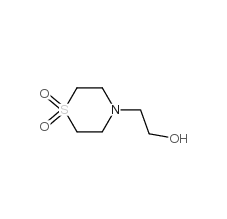Products
Basic information
Chinese name: 4-(2-Hydroxyethyl)thiomorpholine-1,1-dioxide
Alias: 4-(2-Hydroxyethyl)thiomorpholine 1,1-dioxide; 2-(1,1-dioxo-thiomorpholine)ethanol;
English name: 2-(1,1-dioxo-1,4-thiazinan-4-yl)ethanol
English Alias: 4-(2-Hydroxyethyl)thiomorpholine 1,1-Dioxide; 4-Thiomorpholineethanol,1,1-dioxide;
CAS No.: 26475-62-7
Molecular formula: C6H13NO3S
Molecular weight: 179.23700
Precise mass: 179.06200
PSA: 65.99000
Physical and chemical properties
Density: 1.287g/cm3
Melting point: 74 °C
Boiling point: 197 °C / 1 mmHg
Flash point: 197.6oC
Refractive index: 1.516
Vapor pressure: 0mmHg at 25°C
GHS Classification
Physical hazards not classified
Health hazards not classified
Environmental hazards not classified
GHS Labeling Elements
Icons or hazard symbols not available
Signal word no signal word
Hazard description none
Precautionary statements none
Module 3. Ingredient/Composition Information
Single substance/mixture Single substance
Chemical name (Chinese name): 4-(2-hydroxyethyl)thiomorpholine 1,1-dioxide
Percentage: >98.0%(GC)(T)
CAS Code: 26475-62-7
Common name: 2-(1,1-Dioxothiomorpholino)ethanol
Molecular formula: C6H13NO3S
Module 4. First Aid Measures

Inhalation: Move the victim to fresh air, keep breathing open and rest. If unwell, seek medical attention/consultation.
Skin contact: Remove/remove all contaminated clothing immediately. Wash skin with water/shower.
If skin irritation or rash occurs: Seek medical attention/consultation.
EYE CONTACT: Wash carefully with water for several minutes. If convenient and easy to do, remove contact lenses. Continue washing.
If eye irritation: Seek medical attention/consultation.
INGESTION: If discomfort occurs, seek medical attention/consultation. Rinse mouth.
Emergency responder protection: Rescuers need to wear personal protective equipment, such as rubber gloves and airtight goggles.
Module 5. Fire Fighting Measures
Suitable extinguishing agents: dry powder, foam, fog water, carbon dioxide
Special hazards: Caution, may decompose under combustion or high temperatures to produce toxic fumes.
4-(2-hydroxyethyl)thiomorpholine 1,1-dioxide Modification No.: 5
Module 5. Fire Fighting Measures
Specific methods: Extinguish the fire from upwind and choose the appropriate fire fighting method according to the surrounding environment.
Non-relevant personnel should be evacuated to a safe place.
In case of fire in the surroundings: If safe, remove removable containers.
Special protective gear for firefighters: Always wear personal protective equipment when extinguishing a fire.
Module 6. Spill Response
Personal protective measures, protective gear, use personal protective equipment. Stay away from the spill/leak and upwind.
Emergency measures: Spill area should be enclosed with safety belts, etc., to control access by non-relevant personnel.
Environmental measures: Prevent entry into sewers.
Methods and materials for control and cleaning: Sweep up and collect dust and seal into airtight containers. Take care not to disperse. Attachments or collections should be immediately disposed of in accordance with appropriate
Legal regulations.
Module 7. Handling Disposal and Storage
Disposal
Technical measures: Handle in a well-ventilated area. Wear appropriate protective equipment. Prevent dust from spreading. Wash hands and face thoroughly after handling.
and face.
Caution: If dust or aerosols are generated, use local exhaust.
Handling and disposal precautions: Avoid contact with skin, eyes and clothing.
Storage
Storage conditions: Keep container airtight. Store in a cool, dark place.
Store in an inert gas environment.
Store away from incompatible materials such as oxidizing agents.
Gas Sensitive
Packaging materials: according to the law.
Module 8. Exposure control and individual protection
Engineering controls: Install closed systems or local exhaust systems where possible and operators should never come into direct contact. Also install showers and eye washers.
Eye washers.
Personal protective equipment
Respiratory protection: Dust masks. In accordance with local and government regulations.
Hand protection: protective gloves.
Eye protection: Safety goggles. Mask, if required.
Skin and body protection: Protective clothing. Protective boots, if required.
Module 9: Physical and Chemical Properties
Solids
Form (20°C).
Appearance: Crystalline – powder
Color: White – slightly light reddish yellow
Odor: No data available
pH:No data available
Melting point.
74 °C
Boiling point/boiling range 197 °C/0.1 kPa
Flash point: no data available
Explosive properties
Lower explosion limit: no information available
Upper explosion limit: no information available
Density: no information available
Solubility.
[water] no information available
4-(2-Hydroxyethyl)thiomorpholine 1,1-dioxide Modification Number: 5
Module 9. Physicochemical properties
[Other solvents]
Soluble in: methanol
Module 10. Stability and reactivity
Chemical Stability: Generally stable.
Potential for hazardous reactions: No particular reactivity reported.
Substances to be avoided oxidants
Hazardous decomposition products: Carbon monoxide, carbon dioxide, nitrogen oxides (NOx), sulfur oxides
Module 11. Toxicological information
Acute toxicity: No information available
Skin corrosion or irritation: No information available
Severe damage or irritation to eyes: No information available
Germ cell mutagenicity: No information available
Carcinogenicity.
IARC = no information available
NTP = no information available
Reproductive toxicity: no information available
Module 12. ecological information
Ecotoxicity.
Fish: no information available
Crustaceans: no information available
Algae: No information available
Residual / Degradability: No information available
Potential bioaccumulation (BCF): No information available
Mobility in Soil
log water partition coefficient: not available
Soil absorption coefficient (Koc): not available
Henry’s law not available
constant(PaM3/mol):
Module 13. Disposal
If possible, recycle for disposal. Consult local regulatory authorities. It is recommended to dissolve the mixture in a combustible solvent and incinerate in a chemical incinerator equipped with an afterburner and scrubber
Incineration. Observe all national, regional and local regulations when disposing.
Module 14. Transport Information
UN classification: not consistent with UN classification standards
UN number: not specified
Storage and transportation.
Should be sealed and stored in a dry, cool and ventilated warehouse
Package.
200KG/drum Storage: It is recommended to store in dry and cool area with proper ventilation.
Please fasten the lid as soon as possible after the original packaging to prevent the mixing of other substances such as water and other substances from affecting the product performance.
Do not inhale dust and avoid skin and mucous membrane contact. Smoking, eating and drinking are prohibited in the workplace. After work, shower and change clothes.
Store contaminated clothes separately and wash them before use. Maintain good hygiene habits.


